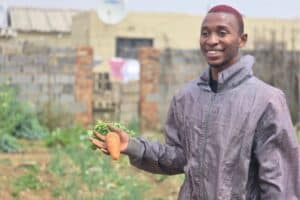One shouldn’t forget Mother-in-law’s tongue (Sansevieria) in its variations.

Gardening wasn’t easy over the past year. Scorching dry days alternated with cold, rainy spells and flooding in many areas.
However, it gave notice that gardening in the future will be about coping with extremes. That will affect our choice of plants, how we use, and store water, landscaping options, and the ways we reduce our carbon footprint.
The upside of water restrictions, among others, was that the toughest plants stood out. They survived on minimal or no water, except rainfall and maybe occasional watering. The garden survivors that I noticed were a mix of indigenous and exotic shrubs.
For toughness nothing can beat the indigenous blue plumbago, Cape honeysuckle (Tecomaria capensis), and the Ribbon Bush (Hypoestes aristata) along with exotic species like Duranta Sheena’s Gold, Abelia grandiflora, Melaleuca Johannesburg Gold, and the fragrant Murraya exotica.
They provide flowers, colourful foliage, fragrance, and the indigenous varieties attract birds and butterflies. Succulents made their presence felt last year and gardeners fell in love with them, producing beautiful pavement plantings, popped them in pots, and made a show of them in the garden, often with other heat-tolerant plants.
My favourites include Euphorbia Firesticks which are tall with yellow “sticks” that become fiery in winter, Spekboom, for its ability to sequester carbon dioxide and clean the air, and the redleaved Kalanchoe that contrasts beautifully with silvery-leaved senecios echeveria (rock roses) and non-indigenous agave that is a magnificent feature plant.
One shouldn’t forget Mother-in-law’s tongue (Sansevieria) in its variations. Its sword-like leaves add contrast and texture to any garden bed. Other garden plants that proved their worth were Euphorbia Breathless that looks like Baby’s Breath but needs almost no attention and Salvia Mystic Spires that is virtually indestructible.
There is now an improved version, Salvia Mysticy that is as tough but more compact. Another new salvia, Salmia, is as showy and as hardy. The days of easy watering are over. Explore every possible way to save or re-use water.
Invest in a rainwater tank, use grey water from the shower or bath, even on vegetables). Remove water guzzling weeds, use water-retaining products in the soil, and cover tender vegetables with shade cloth. Water before 6am or after 6pm, the coolest times of the day.
Heatproof beds with a thin 1 – 2cm layer of organic mulch (peanut shells, hay, bark chips). It keeps the soil cool, reducing evaporation and the soil stays moist for longer. Keep on replenishing the layer. Another way to make the best use of rainwater is to increase the permeable garden floor so rainwater soaks in.
Use permeable pavers, replace solid paving with pavers set into sand/gravel or use Mondo grass, groundcovers or aromatic herbs in-between stepping-stones. As more and more habitats are lost to development, we can make our gardens wildlife friendly and encourage our neighbours to do the same.
When choosing plants, also opt for trees, shrubs, flowers and grasses that attract butterflies, birds, bees, and the myriad of other garden wildlife that we don’t even realise is there. By reconnecting fragmented habitats, we can help wildlife find ways to cope with the impact of climate change.
Recycling waste is an effective way to reduce our carbon footprint. Almost all kitchen waste can go into a compost heap, wormery or Bokashi bin. Homemade compost is a sustainable source of nutrition. Wormeries also yield highly nutritious compost and liquid drenches (diluted in water).
Renew the soil with compost in spring and with each new planting. Happy, creative, sustainable gardening for 2020.
For more news your way, download The Citizen’s app for iOS and Android.






